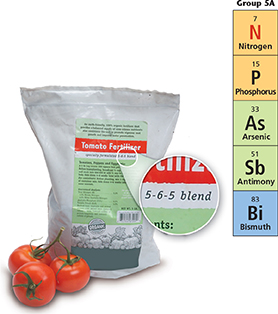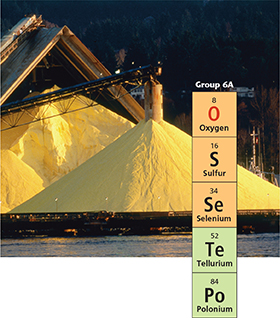The Nitrogen Family
Group 5A contains two nonmetals (nitrogen and phosphorus), two metalloids (arsenic and antimony), and one metal (bismuth). Like the groups on either side of it, Group 5A includes elements with a wide range of physical properties. Nitrogen is a nonmetal gas, phosphorus is a solid nonmetal, and bismuth is a dense metal. Despite their differences, all the elements in Group 5A have five valence electrons. Nitrogen and phosphorus are the most important elements in Group 5A.
When air is cooled, the oxygen condenses before the nitrogen because nitrogen has a lower boiling point than oxygen. Much of the nitrogen obtained from air is used to produce fertilizers, like the three shown in Figure 19.  Besides nitrogen, fertilizers often contain phosphorus. Your body uses compounds containing nitrogen and phosphorus to control reactions and release energy from food.
Besides nitrogen, fertilizers often contain phosphorus. Your body uses compounds containing nitrogen and phosphorus to control reactions and release energy from food.
Phosphorus exists as an element in several forms with different properties. White phosphorus is so reactive that it bursts into flame when it is in contact with oxygen. Red phosphorus is less reactive and is used to make matches ignite.
Figure 19 The composition of a fertilizer varies with its intended use. The numbers on the bags of fertilizer are, from left to right, the relative amounts of nitrogen, phosphorus, and potassium.
Analyzing Data Which type of fertilizer contains the most phosphorus?

Figure 20 Sulfur is often found in nature in its elemental form—not combined with other elements. Inferring What does this information tell you about the reactivity of sulfur?

The Oxygen Family
Group 6A has three nonmetals (oxygen, sulfur, and selenium), and two metalloids (tellurium and polonium). All the elements in Group 6A have six valence electrons.
 Oxygen is the most abundant element in Earth's crust. Complex forms of life need oxygen to stay alive because oxygen is used to release the energy stored in food. Oxygen can be stored as a liquid under pressure in oxygen tanks. There must be no sparks or flames near an oxygen tank because materials that are flammable burn easily in pure oxygen.
Oxygen is the most abundant element in Earth's crust. Complex forms of life need oxygen to stay alive because oxygen is used to release the energy stored in food. Oxygen can be stored as a liquid under pressure in oxygen tanks. There must be no sparks or flames near an oxygen tank because materials that are flammable burn easily in pure oxygen.
Ozone is another form of the element oxygen. At ground level, ozone can irritate your eyes and lungs. At upper levels of the atmosphere, ozone absorbs harmful radiation emitted by the sun.
Sulfur was one of the first elements to be discovered because it is found in large natural deposits like the one in Figure 20. The main use of sulfur is in the production of sulfuric acid, a compound of sulfur, hydrogen, and oxygen. More sulfuric acid is produced in the United States than any other chemical. About 65 percent of the sulfuric acid produced is used to make fertilizers.




